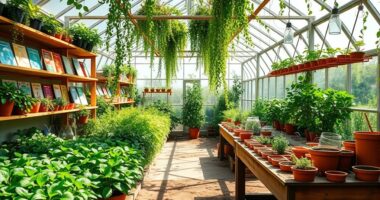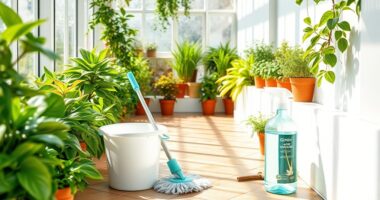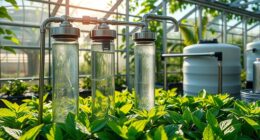To keep your greenhouse clean, regularly remove debris, dead plant material, and old foliage to prevent pests and disease spread. Sanitize containers, pots, and equipment with eco-friendly disinfectants, and verify proper airflow and ventilation to reduce humidity and mold. Address weeds and pests promptly, and schedule routine deep cleaning sessions. Using sustainable cleaning products keeps your environment healthy and eco-conscious. Keep these practices in mind to foster a thriving, pest-free space—more tips are ahead.
Key Takeaways
- Regularly remove debris, dead plant material, and old foliage to prevent disease and pest buildup.
- Disinfect tools, containers, and high-touch surfaces with eco-friendly solutions like vinegar or diluted bleach.
- Ensure proper ventilation and airflow using fans and open vents to reduce humidity and prevent mold.
- Conduct routine inspections for pests, weeds, and disease, addressing issues promptly with targeted, organic methods.
- Maintain a clean environment through scheduled deep cleaning, humidity control, and sustainable practices to promote plant health.
Regularly Remove Debris and Dead Plant Material
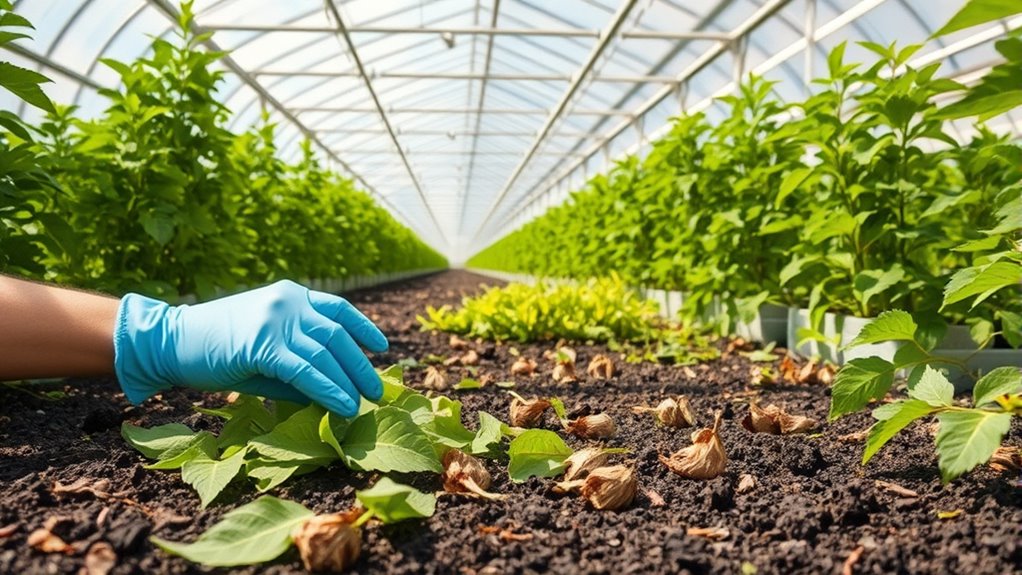
To keep your greenhouse healthy, you need to regularly remove debris and dead plant material. This practice prevents disease spread and keeps pests at bay. As you clean, consider using effective mulching techniques to protect soil and retain moisture, which also reduces debris buildup. Composting methods are essential for recycling plant waste; add dead leaves and plant matter to your compost bin to create nutrient-rich soil for future use. Regularly clearing out old foliage prevents fungal issues and promotes healthy growth. Be diligent about removing fallen leaves, stems, and other debris, especially after pruning or harvesting. Incorporating sustainable practices into your routine encourages responsible environmental stewardship and minimizes waste. Additionally, inspecting your greenhouse regularly for structural damage or leaks can help prevent pest entry and maintain a controlled environment. Using pest control methods can further protect your plants and ensure a healthy growing space. Maintaining a tidy environment not only controls pests but also encourages ideal plant health and productivity. Staying consistent with debris removal and composting ensures your greenhouse remains a thriving, pest-free space.
Disinfect Surfaces and Equipment
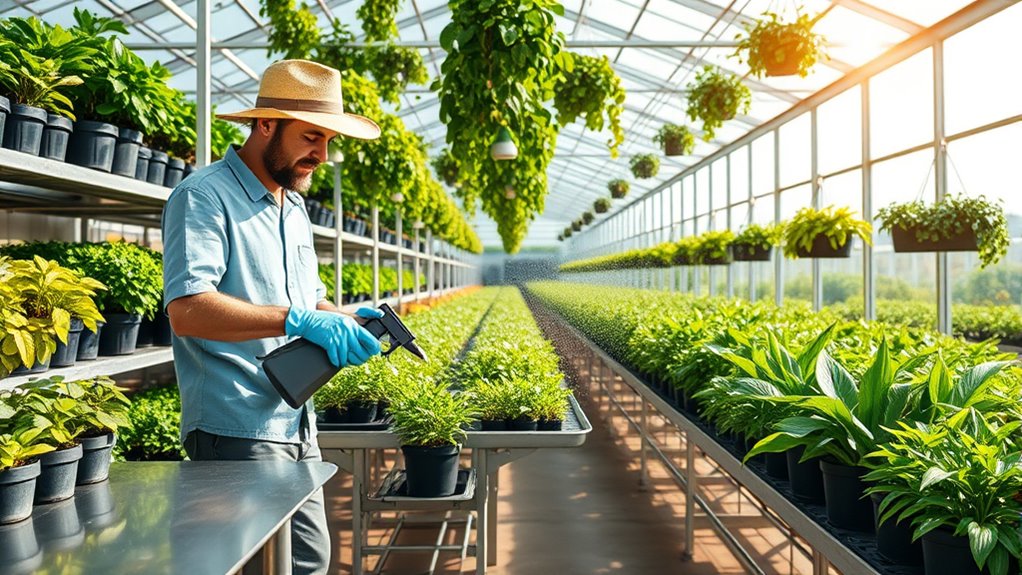
You need to disinfect high-touch areas and equipment regularly to prevent disease spread. Use effective disinfectants that are proven to kill common pathogens in greenhouses. Proper sanitation keeps your plants healthy and reduces the risk of contamination. Implementing consistent cleaning protocols can also help maintain a hygienic environment and prevent outbreaks. Additionally, using immersive soundscapes during staff training or educational videos can enhance understanding of sanitation procedures and encourage compliance. Staying informed about AI-driven security systems can further protect your greenhouse from cyber threats that could disrupt your operations. Regular monitoring of sanitation practices and staying updated on emerging safety standards are essential for optimal health management. Incorporating community engagement into your sanitation efforts can foster collective responsibility and improve overall biosecurity.
Sanitize High-Touch Areas
High-touch surfaces and equipment in your greenhouse can harbor pests, diseases, and bacteria that threaten plant health. That’s why touchpoint sanitation is vital. Regularly disinfect tools, door handles, bench surfaces, and watering cans to prevent pathogen spread. Incorporate surface disinfecting practices that utilize appropriate cleaning agents to effectively eliminate microbes. This routine reduces the risk of cross-contamination and keeps your greenhouse environment healthier. Implementing proper tuning techniques can also improve equipment efficiency and longevity, supporting a healthier growing environment. Properly sanitizing these areas minimizes disease transfer, protecting your crops and maintaining ideal growth conditions. Adopting preventative measures like routine cleaning schedules can significantly reduce the chances of outbreaks. For added protection, consider using antimicrobial disinfectants that are safe for plants and effective against a broad spectrum of pathogens.
Use Effective Disinfectants
Effective disinfectants are key to ensuring that your greenhouse surfaces and tools stay free of harmful pathogens. Choosing the right chemical agents or natural solutions can make all the difference in maintaining a healthy environment.
Using effective disinfectants helps prevent disease spread, protects your plants, and boosts your greenhouse’s productivity. When selecting disinfectants, consider options that are proven to work against common pathogens.
Remember, some natural solutions like vinegar or hydrogen peroxide can be just as effective as chemical agents if used correctly. Always follow manufacturer instructions for proper application and contact time.
Additionally, understanding the importance of indoor air quality can help you create a healthier environment for both your plants and yourself. By prioritizing effective disinfectants, you create a safer, cleaner space for your plants to thrive.
- Feel confident in your protection against plant diseases
- Experience peace of mind knowing your tools are sanitized
- Gain pride in maintaining a healthy greenhouse environment
Maintain Proper Ventilation and Air Circulation
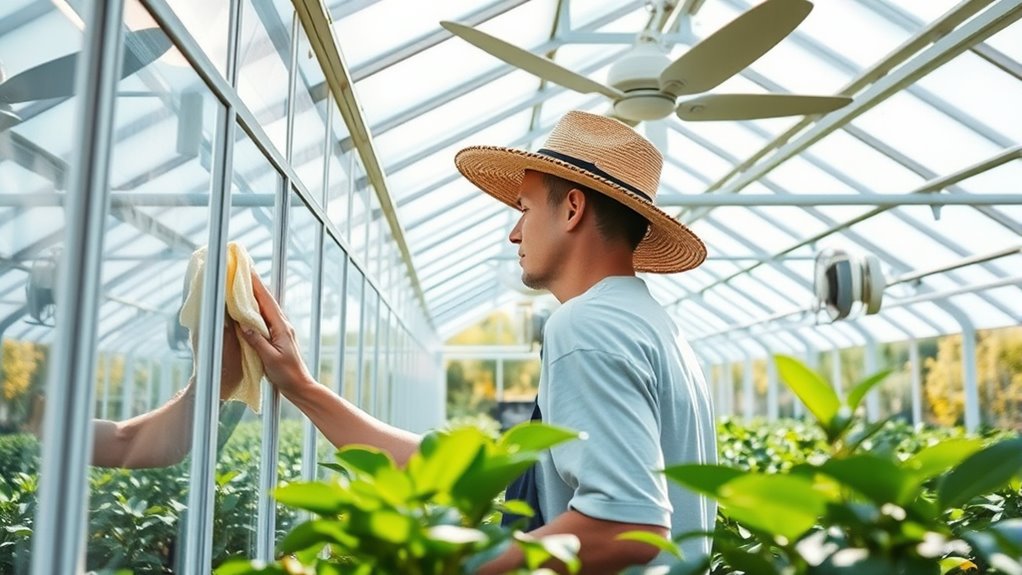
Good airflow is key to keeping your greenhouse healthy, so make sure it’s properly ventilated. Use fans effectively to move air around and prevent stagnant spots. Keep an eye on humidity levels to avoid excess moisture that can cause problems. Monitoring air circulation can help prevent mold growth and other issues caused by poor ventilation. Proper ventilation also supports plant health, ensuring your crops thrive and remain resilient to pests and diseases. Additionally, maintaining adequate ventilation systems can optimize temperature control and promote strong plant growth. Regularly inspecting and cleaning your filtration systems helps maintain optimal airflow and reduces the risk of airborne pathogens.
Ensure Adequate Airflow
Maintaining proper ventilation and air circulation is essential for a healthy greenhouse environment. Ensuring adequate airflow prevents mold, reduces pests, and promotes vigorous plant growth. Focus on airflow regulation and ventilation optimization to keep conditions just right. Proper air circulation also helps distribute temperature and humidity evenly throughout your space, creating a more stable environment for your plants. When airflow is consistent, you’ll notice healthier plants and fewer disease issues. To enhance ventilation:
- Keep vents open and unobstructed to maximize airflow.
- Regularly inspect and clean air intakes and exhausts.
- Use natural airflow paths to create a steady breeze throughout your space.
- Understanding ventilation management can further improve air quality and plant health.
- Incorporating climate control systems can automate and fine-tune airflow for optimal conditions.
Use Fans Effectively
Using fans properly is crucial for ensuring consistent air circulation within your greenhouse. To achieve this, pay close attention to fan placement; position fans so they promote even airflow throughout all areas, avoiding dead spots. Proper placement helps create effective airflow patterns, preventing stagnant air and reducing the risk of disease.
Use oscillating fans for broader coverage and ensure they’re mounted at the right height—typically around plant canopy level for optimal circulation. Avoid directing fans straight at plants, which can cause stress, and instead aim for gentle, indirect airflow.
Regularly check and adjust fan positioning to maintain balanced airflow patterns. Properly used fans help regulate temperature, reduce humidity build-up, and promote healthy plant growth, making your greenhouse a more productive environment.
Monitor Humidity Levels
Monitoring humidity levels is essential for maintaining a healthy greenhouse environment, especially since fluctuations can lead to problems like mold, disease, or stress for your plants. You need to regularly check humidity to prevent these issues.
Ensure your humidifier calibration is accurate so your plants aren’t exposed to excessive moisture or dryness. Keep your misting system maintenance up to date, avoiding clogs or leaks that could cause uneven humidity.
Use ventilation fans effectively to circulate air and regulate moisture levels. Remember, a well-balanced environment promotes healthy growth and reduces plant stress.
- Feel the relief of thriving plants with perfect humidity control
- Avoid the heartbreak of mold and disease spreading unnoticed
- Experience the confidence of a well-maintained, healthy greenhouse
Control Humidity and Moisture Levels

Controlling humidity and moisture levels is vital for a healthy greenhouse environment. You can achieve this by using misting techniques to add moisture when needed, ensuring plants stay hydrated without overdoing it. Humidity sensors are invaluable tools; they provide real-time data, helping you maintain perfect conditions.
Maintaining optimal humidity with misting and sensors ensures healthy, thriving greenhouse plants.
When humidity levels are too high, increase ventilation or use dehumidifiers to reduce excess moisture. Conversely, if levels are too low, mist plants lightly or adjust watering schedules.
Proper airflow is also essential, so keep vents open and fans running to prevent stagnation. Regularly monitoring with sensors allows you to make timely adjustments, reducing disease risks and promoting healthy growth.
Consistent control of humidity and moisture creates an ideal environment for your plants to thrive.
Clean and Sterilize Containers and Pots
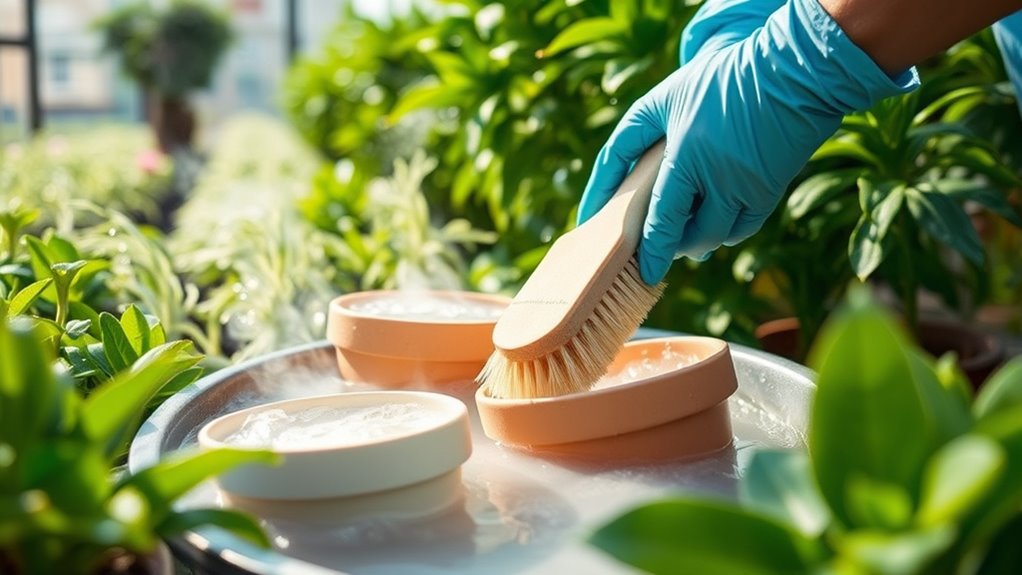
Before planting new seedlings, it’s essential to thoroughly clean and sterilize all containers and pots. Proper sterilizing containers prevents the spread of disease and guarantees healthy plant growth.
Start by selecting cleaning agents that are effective against pathogens yet safe for your plants. Use a brush or scrubber to remove dirt and debris from each pot.
Then, soak or wash the containers in a disinfectant solution, such as a diluted bleach mixture or commercial sterilizer, to eliminate bacteria and fungi. Rinse thoroughly and let them dry completely before reuse.
- Feel confident knowing you’re creating a safe environment for your plants.
- Experience peace of mind as you prevent pests and disease.
- Enjoy the satisfaction of a clean, thriving greenhouse.
Manage Weeds and Pests Promptly

Weed and pest problems can quickly escalate if you don’t address them promptly, so it’s important to stay vigilant and act as soon as you notice any issues. Effective weed control prevents unwanted plants from competing with your crops for nutrients and light. Regular inspection helps you catch pests early before they cause significant damage.
For pest management, identify pests quickly and use targeted methods like traps or organic insecticides to minimize broader impacts. Removing weeds manually or with tools reduces hiding spots for pests and prevents them from spreading.
Promptly managing weeds and pests keeps your greenhouse healthy and reduces the need for extensive treatments later. Staying proactive ensures your plants stay strong and your greenhouse remains a productive, pest-free environment.
Schedule Routine Deep Cleaning Sessions
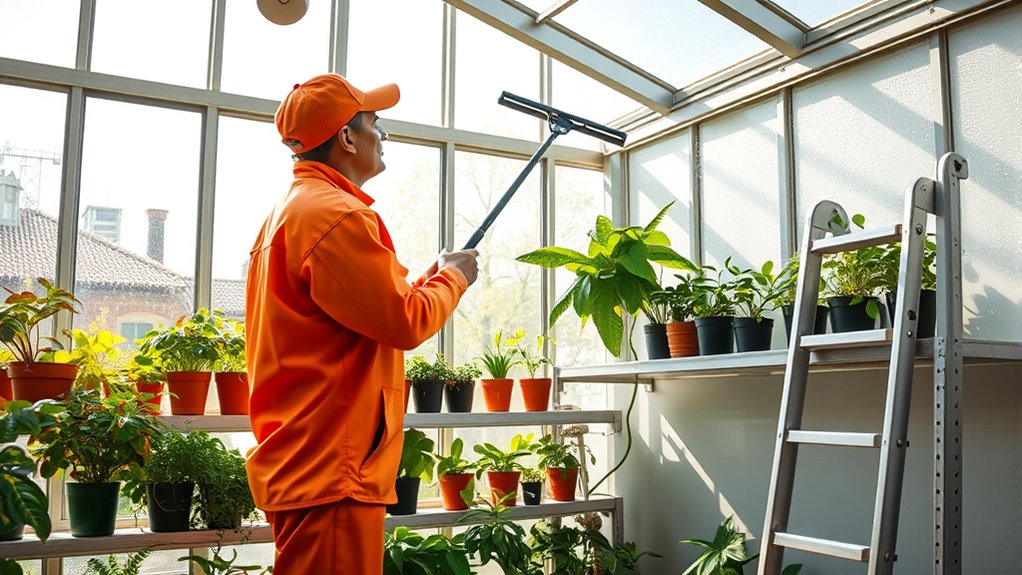
Scheduling routine deep cleaning sessions is essential to maintaining a healthy and productive greenhouse environment. Regular deep cleans help you prevent pests and support ideal plant growth by removing accumulated dirt, algae, and debris.
Regular deep cleans keep your greenhouse healthy, pest-free, and thriving.
By committing to these sessions, you create a safer space that discourages pests and promotes healthier plants.
- Feel confident knowing you’re actively protecting your plants’ future
- Experience the satisfaction of a pest-free, thriving greenhouse
- Watch your plants flourish as you maintain a pristine environment
Deep cleaning not only boosts plant growth but also minimizes pest issues before they start.
Consistency in this practice will give you peace of mind, knowing your greenhouse remains a clean, safe haven for your plants to thrive.
Use Eco-Friendly Cleaning Products
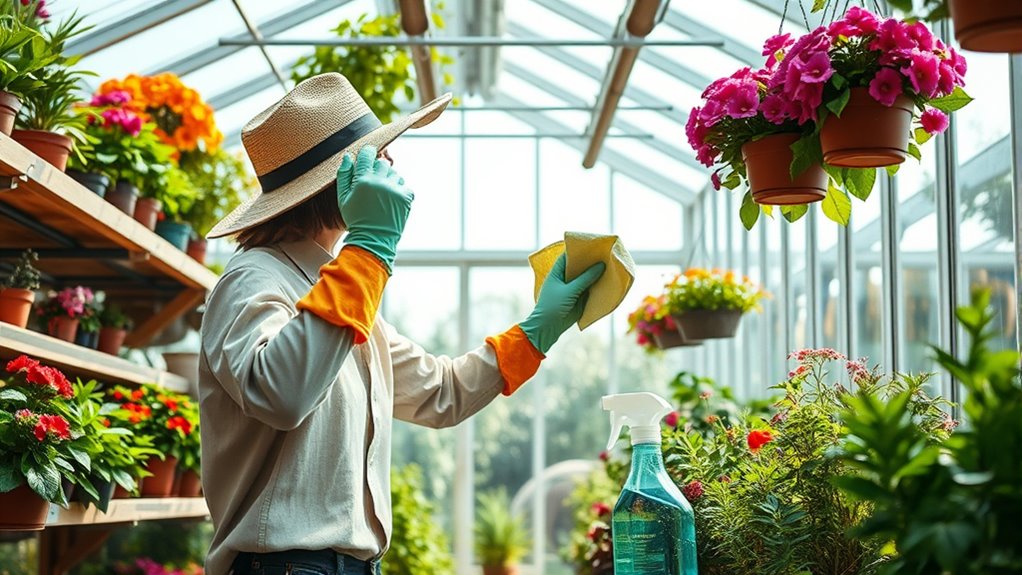
Choosing eco-friendly cleaning products for your greenhouse guarantees you maintain a healthy environment for both your plants and the planet. Opt for biodegradable cleaners that break down naturally, reducing environmental impact. Natural disinfectants, like vinegar or hydrogen peroxide, effectively sanitize surfaces without harmful chemicals.
These options are safe for your plants, workers, and beneficial insects. When cleaning, avoid harsh synthetic chemicals that can linger and harm your greenhouse ecosystem. Instead, focus on plant-safe, eco-friendly solutions that clean thoroughly without compromising air quality or soil health.
Using natural disinfectants can also help prevent the spread of pests and diseases naturally. By selecting environmentally conscious cleaning products, you support sustainable gardening practices and ensure your greenhouse remains a safe, thriving space for your plants.
Frequently Asked Questions
How Often Should I Perform Deep Cleaning in My Greenhouse?
You should perform a deep cleaning in your greenhouse at least once a season to maintain ideal conditions. This seasonal cleaning helps prevent pests and diseases by removing debris, mold, and algae.
Regular deep cleaning also promotes healthier plants and better airflow. Don’t forget to disinfect surfaces and tools afterward to guarantee pest prevention.
Staying consistent with these cleanings keeps your greenhouse a thriving environment for your plants.
What Signs Indicate My Greenhouse Needs a Thorough Cleaning?
Think of your greenhouse as a well-tuned machine—if it starts to sputter, it’s time for a check-up. You’ll notice signs like mold, algae, or excessive debris during inspections, signaling a need for thorough cleaning.
Pest management becomes tougher when dirt and grime hide problem areas. Regularly inspecting and cleaning your greenhouse helps maintain a healthy environment, keeping pests at bay and ensuring your plants thrive.
Are There Specific Cleaning Products for Organic Greenhouse Maintenance?
When you ask about specific cleaning products for organic greenhouse maintenance, you’re focusing on eco-friendly solutions. You should look for organic cleaning products that use natural ingredients like vinegar, baking soda, or castile soap.
These options guarantee you’re maintaining your greenhouse sustainably without harmful chemicals. Always check labels to confirm they’re certified organic and safe for plants, helping you keep your greenhouse clean while supporting eco-friendly practices.
How Can I Prevent Mold and Mildew Buildup Effectively?
Did you know mold and mildew can develop in as little as 48 hours? To prevent buildup, you should focus on improving air circulation and humidity control.
Make certain your greenhouse has proper ventilation and avoid excess moisture by using dehumidifiers if needed. Regularly monitor humidity levels, keeping them below 60%, and wipe down surfaces to reduce potential mold growth.
This helps protect your plants and ensures a healthy environment.
What Are the Best Practices for Cleaning Greenhouse Lighting Fixtures?
When cleaning greenhouse lighting fixtures, you should regularly inspect for dust and dirt buildup.
Use a soft, damp cloth to gently wipe LED fixtures to prevent damage and ensure ideal LED maintenance.
Make sure to check fixture alignment after cleaning to maintain proper light distribution.
Avoid harsh chemicals, and turn off the lights before cleaning.
Regular maintenance keeps your lighting efficient and prolongs fixture lifespan.
Conclusion
By keeping your greenhouse spotless, you create a healthy haven for your plants to thrive. Imagine a space where debris and pests are gone, replaced by fresh air and clean surfaces. It’s the difference between a cluttered, disease-prone environment and a vibrant, flourishing oasis. Regular cleaning might seem simple, but it’s your best tool for cultivating lush growth and preventing problems. Stay consistent, and watch your greenhouse become the thriving paradise you envision.


